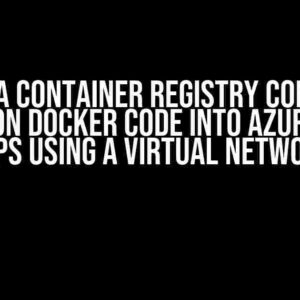Are you tired of manually validating builds across multiple repositories in Azure DevOps? Do you wish there was a way to automate this process and ensure consistency across your pipelines? Look no further! In this article, we’ll explore the concept of Azure DevOps build validation from a pipeline in another repository and provide a step-by-step guide on how to achieve it.
Why Validate Builds Across Repositories?
Validating builds across repositories is crucial in ensuring that changes made in one repository do not break the build in another. This is especially important in large-scale development environments where multiple teams work on different components that need to integrate seamlessly. By validating builds, you can:
- Ensure consistency across pipelines
- Reduce the risk of breaking changes
- Improve collaboration and communication among teams
- Streamline your Continuous Integration/Continuous Deployment (CI/CD) workflow
Prerequisites
Before we dive into the implementation, make sure you have the following:
- Azure DevOps account with permissions to create and manage pipelines
- Two or more repositories in Azure DevOps containing the pipelines you want to validate
- Basic understanding of YAML and Azure DevOps pipelines
Understanding the Concept
Azure DevOps build validation from a pipeline in another repository involves triggering a validation pipeline in one repository whenever a build is triggered in another. This ensures that changes made in the first repository do not break the build in the second.
The process can be broken down into two stages:
- Triggering the validation pipeline in the second repository
- Validating the build in the second repository
Implementation
Let’s create a pipeline in Azure DevOps that triggers a validation pipeline in another repository. We’ll use a simple example to demonstrate this.
Step 1: Create a New Pipeline
Create a new pipeline in Azure DevOps by clicking on the “New pipeline” button in the Pipelines section. Name the pipeline (e.g., “Validation Pipeline”) and choose the YAML editor.
trigger:
- main
pool:
vmImage: 'ubuntu-latest'
steps:
- task: Bash@3
displayName: 'Run a script'
inputs:
command: 'bash'
workingDirectory: '/'
script: |
# Your script here
Step 2: Trigger the Validation Pipeline
To trigger the validation pipeline in the second repository, we’ll use the “Trigger Azure DevOps pipeline” task. Add the following YAML code to your pipeline:
steps:
- task: TriggerAzureDevOpsPipeline@2
displayName: 'Trigger validation pipeline'
inputs:
azureDevOpsOrg: ''
azureDevOpsProject: ''
pipelineId: ''
variables: 'build.repository.name=$(Build.Repository.Name)'
Replace `
Step 3: Validate the Build
In the validation pipeline, we’ll use the “Azure DevOps pipeline artifact” task to download the build artifact from the first repository. Add the following YAML code to your validation pipeline:
steps:
- task: DownloadPipelineArtifact@2
displayName: 'Download build artifact'
inputs:
artifactName: 'drop'
downloadPath: '$(System.ArtifactsDirectory)'
Next, we’ll use the “Bash” task to validate the build. Add the following YAML code:
steps:
- task: Bash@3
displayName: 'Validate build'
inputs:
command: 'bash'
workingDirectory: '/'
script: |
# Your validation script here
# Example: npm install && npm run test
Replace the script with your actual validation script.
Putting it all Together
Here’s the complete YAML code for the pipeline:
trigger:
- main
pool:
vmImage: 'ubuntu-latest'
steps:
- task: TriggerAzureDevOpsPipeline@2
displayName: 'Trigger validation pipeline'
inputs:
azureDevOpsOrg: ''
azureDevOpsProject: ''
pipelineId: ''
variables: 'build.repository.name=$(Build.Repository.Name)'
- task: Bash@3
displayName: 'Run a script'
inputs:
command: 'bash'
workingDirectory: '/'
script: |
# Your script here
And for the validation pipeline:
trigger:
- none
pool:
vmImage: 'ubuntu-latest'
steps:
- task: DownloadPipelineArtifact@2
displayName: 'Download build artifact'
inputs:
artifactName: 'drop'
downloadPath: '$(System.ArtifactsDirectory)'
- task: Bash@3
displayName: 'Validate build'
inputs:
command: 'bash'
workingDirectory: '/'
script: |
# Your validation script here
# Example: npm install && npm run test
Troubleshooting
If you encounter any issues during implementation, here are some common errors and solutions:
| Error | Solution |
|---|---|
| TriggerAzureDevOpsPipeline task fails | Check that the pipeline ID, organization, and project IDs are correct. |
| DownloadPipelineArtifact task fails | Verify that the artifact name is correct and the pipeline is producing the artifact. |
| Validation script fails | Check the script for syntax errors and ensure that the necessary dependencies are installed. |
Conclusion
In this article, we’ve demonstrated how to implement Azure DevOps build validation from a pipeline in another repository. By automating this process, you can ensure consistency across your pipelines, reduce the risk of breaking changes, and improve collaboration among teams. Remember to tailor the implementation to your specific use case and troubleshooting needs.
By following this guide, you’ll be able to:
- Trigger a validation pipeline in another repository
- Download the build artifact from the first repository
- Validate the build using a custom script
Happy automating!
Frequently Asked Questions
Get answers to your most pressing questions about Azure DevOps build validation from a pipeline in another repository!
What is Azure DevOps build validation, and why do I need it?
Azure DevOps build validation is a process that ensures your code changes meet the required quality and security standards before they’re merged into your main branch. You need it to avoid bugs, security vulnerabilities, and inconsistencies in your codebase. Think of it as a gatekeeper that saves you from headaches down the line!
How do I trigger a build validation from a pipeline in another repository?
You can trigger a build validation from a pipeline in another repository by using the Azure DevOps REST API or Azure Pipelines YAML pipeline. You’ll need to create a pipeline that calls the build validation API or uses a YAML pipeline with a trigger that references the other repository. Don’t worry, it’s easier than it sounds!
What are the benefits of using build validation from a pipeline in another repository?
Using build validation from a pipeline in another repository helps you maintain a consistent quality and security standard across multiple repositories. It also enables you to reuse pipeline code and reduce maintenance efforts. Plus, it gives you the flexibility to trigger builds from multiple sources, making it easier to manage complex workflows!
Can I customize the build validation process to fit my team’s specific needs?
Absolutely! You can customize the build validation process by creating your own custom scripts, tasks, or plugins. You can also integrate with other Azure DevOps services, such as Azure Boards or Azure Test Plans, to create a tailored validation process that fits your team’s unique requirements. The possibilities are endless!
What kind of reporting and analytics can I expect from Azure DevOps build validation?
Azure DevOps build validation provides detailed reporting and analytics on build success rates, test results, and code quality metrics. You can use these insights to identify trends, optimize your pipeline, and make data-driven decisions to improve your team’s overall performance. It’s like having a personal coach for your code!




